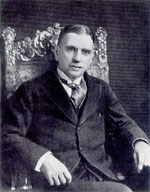 The Wells Homestead Subdivision: A Community Is Born
The Wells Homestead Subdivision: A Community Is Born
After the destruction of the Wells mansion, Rolla Wells – Erastus’s son and St. Louis City mayor – subdivided the estate, and a community was born. Rolla Wells originally referred to the area as the Wells Homestead Subdivision, but it was soon renamed Wells Town (and eventually Wellston) in honor of Erastus Wells.
A new phase in Wellston’s history began at this point. Transportation, schools, recreation, industry, business, and shopping all began to develop rapidly, and Wellston took on the shape of a town. The community of Wellston soon developed “where there had long been a transportation center. It soon became a major shopping district.”
Transportation, which had been central to the country area earlier and which would later be influential in the establishment of Wellston as a major transportation hub in St. Louis, proved to be a boost to development and growth in the 1890s as well. Indeed, as the City of St. Louis website notes, “The Wellston Loop ranked among the largest streetcar transfer points in the United States at the turn of the century.”
In his 1894 history Old and New St. Louis, James Cox had this to say about Easton Avenue:
Those visiting St. Louis during the years 1892 and 1893, after an absence from the city of eight or ten years, have been astounded at the changes effected. Specific reference has already been made to the effect of the cable construction on Easton Avenue. This thoroughfare was little more than a country road ten years ago. The single-track street carline was laid on one side of the road, and the service was anything but satisfactory. There were a few stores on the street, but they were general country stores without specialties in any line. Today Easton Avenue is one of the most important thoroughfares in the city. It forms part of the direct road from the Mississippi River at St. Louis to the Missouri River at St. Charles, and, thanks to the influence of the cable, that portion of the St. Charles rock road which is now known as Easton avenue, is a busy thoroughfare, with hundreds of stores and private dwellings. Several attempts have been made to state in figures what benefit the cable road has been to Easton avenue, but sufficient data are not at hand to make a calculation approximately accurate. It is certain, however, that property which could not be sold at $10 a foot before the reconstruction, now has buyers in abundance at $50, $60 and $70, with higher prices for corners.
Easton Avenue continued to be a major transportation route well into the twentieth century, and the streetcar line that ran along the thoroughfare was known as the “white line” because, notes the City of St. Louis website, “its cars and trolley line posts were white.”
Next.